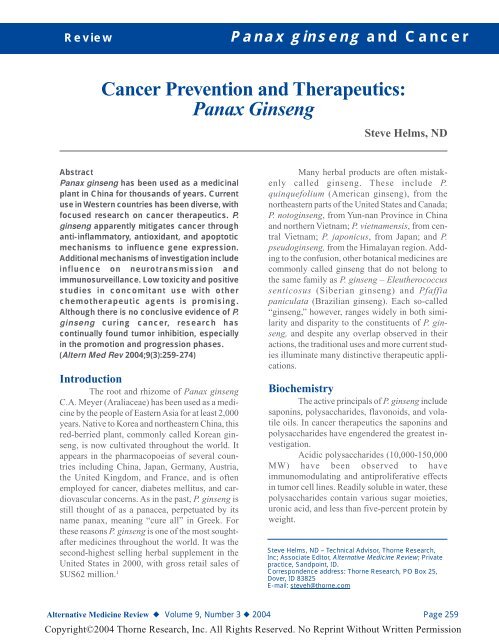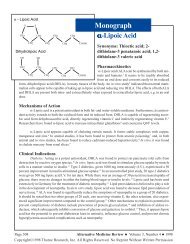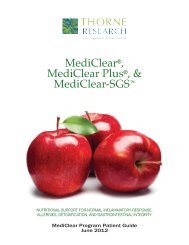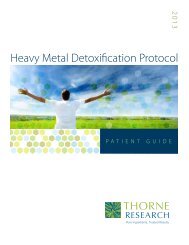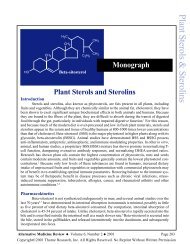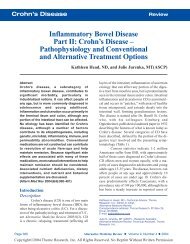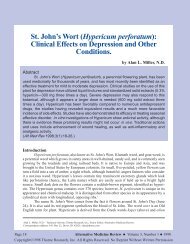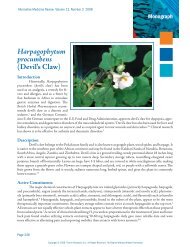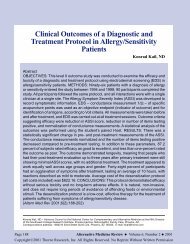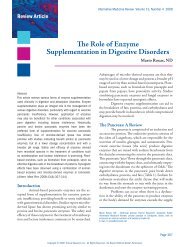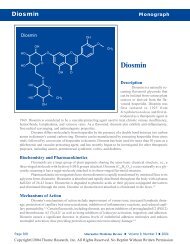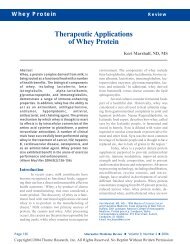Panax Ginseng - Thorne Research
Panax Ginseng - Thorne Research
Panax Ginseng - Thorne Research
Create successful ePaper yourself
Turn your PDF publications into a flip-book with our unique Google optimized e-Paper software.
Review<strong>Panax</strong> ginseng and CancerCancer Prevention and Therapeutics:<strong>Panax</strong> <strong>Ginseng</strong>Steve Helms, NDAbstract<strong>Panax</strong> ginseng has been used as a medicinalplant in China for thousands of years. Currentuse in Western countries has been diverse, withfocused research on cancer therapeutics. P.ginseng apparently mitigates cancer throughanti-inflammatory, antioxidant, and apoptoticmechanisms to influence gene expression.Additional mechanisms of investigation includeinfluence on neurotransmission andimmunosurveillance. Low toxicity and positivestudies in concomitant use with otherchemotherapeutic agents is promising.Although there is no conclusive evidence of P.ginseng curing cancer, research hascontinually found tumor inhibition, especiallyin the promotion and progression phases.(Altern Med Rev 2004;9(3):259-274)IntroductionThe root and rhizome of <strong>Panax</strong> ginsengC.A. Meyer (Araliaceae) has been used as a medicineby the people of Eastern Asia for at least 2,000years. Native to Korea and northeastern China, thisred-berried plant, commonly called Korean ginseng,is now cultivated throughout the world. Itappears in the pharmacopoeias of several countriesincluding China, Japan, Germany, Austria,the United Kingdom, and France, and is oftenemployed for cancer, diabetes mellitus, and cardiovascularconcerns. As in the past, P. ginseng isstill thought of as a panacea, perpetuated by itsname panax, meaning “cure all” in Greek. Forthese reasons P. ginseng is one of the most soughtaftermedicines throughout the world. It was thesecond-highest selling herbal supplement in theUnited States in 2000, with gross retail sales of$US62 million. 1Many herbal products are often mistakenlycalled ginseng. These include P.quinquefolium (American ginseng), from thenortheastern parts of the United States and Canada;P. notoginseng, from Yun-nan Province in Chinaand northern Vietnam; P. vietnamensis, from centralVietnam; P. japonicus, from Japan; and P.pseudoginseng, from the Himalayan region. Addingto the confusion, other botanical medicines arecommonly called ginseng that do not belong tothe same family as P. ginseng – Eleutherococcussenticosus (Siberian ginseng) and Pfaffiapaniculata (Brazilian ginseng). Each so-called“ginseng,” however, ranges widely in both similarityand disparity to the constituents of P. ginseng,and despite any overlap observed in theiractions, the traditional uses and more current studiesilluminate many distinctive therapeutic applications.BiochemistryThe active principals of P. ginseng includesaponins, polysaccharides, flavonoids, and volatileoils. In cancer therapeutics the saponins andpolysaccharides have engendered the greatest investigation.Acidic polysaccharides (10,000-150,000MW) have been observed to haveimmunomodulating and antiproliferative effectsin tumor cell lines. Readily soluble in water, thesepolysaccharides contain various sugar moieties,uronic acid, and less than five-percent protein byweight.Steve Helms, ND – Technical Advisor, <strong>Thorne</strong> <strong>Research</strong>,Inc; Associate Editor, Alternative Medicine Review; Privatepractice, Sandpoint, ID.Correspondence address: <strong>Thorne</strong> <strong>Research</strong>, PO Box 25,Dover, ID 83825E-mail: steveh@thorne.comAlternative Medicine Review ◆ Volume 9, Number 3 ◆ 2004 Page 259Copyright©2004 <strong>Thorne</strong> <strong>Research</strong>, Inc. All Rights Reserved. No Reprint Without Written Permission
<strong>Panax</strong> ginseng and CancerReviewTable 1. Noteworthy Ginsenosides (28 are known)<strong>Panax</strong>adiols<strong>Panax</strong>atriolsRb1,Rb2, Rc, Rd, Rg3, Rh220(S)- protopanaxadiols(i.e., 20(S)-Rg3)Compound K, M1, IH901(20-O-β-D-glucopyranosyl-20(S)-protopanaxadiol); <strong>Panax</strong>ydiolKey GinsenosidesMetabolitesFurther MetabolitesRe, Rf, Rg1, Rg2, Rh120(S)- protopanaxatriols(i.e., 20(S)-Rg2 and 20(S)-Rh1)<strong>Panax</strong>ytriol(heptadeca-1-ene-4,6-diyne-3,9,10-triol)<strong>Ginseng</strong>’s saponins, generally calledginsenosides (Rx), are emphasized in cancerchemoprevention and therapeutics. The primaryginsenosides and their metabolic cousins have asteroid-like structure 2,3 and are generated by acidTable 2. Concentrations of Ginsenosides with AgeYears Total Saponins Rb Rg Ro(%) (%) (%) (%)2 1.97 0.88 0.54 0.133 2.20 1.03 0.62 0.174 4.75 2.27 1.10 0.405 4.60 2.08 1.19 0.216 3.84 1.94 0.81 0.299 3.81 2.32 0.46 0.40From: Liu CX, Xiao PG. Recent advances on ginsengresearch in China. J Ethnopharmacol 1992;36(1):27-38.hydrolysis of saponins 4 and human intestinal bacteria.5-7 With the exception of ginsenoside Ro,which is an oleanane-type triterpenoid, allginsenosides are the dammarane-type separatedinto panaxadiol and panaxatriol classes (Table 1).In Asia, the traditional preparationsof fresh white and red ginseng have variousconcentrations of ginsenosides that developin complexity with age (Table 2) and preparation.Classically, fresh ginseng is anythingpicked before four years of growth. Whiteginseng (picked at 4-6 years) is peeled andthen dried, and contains high concentrationsof Rb1, Rb2, Rc, and Rd of the -diol group.Red ginseng (harvested at 6 years) traversesboth ginsenoside classes speaking to liberationof new constituents – Rh1, Rh2, andRg3 – from steaming the dry whole root. 4,8These traditional preparations generate atherapeutic dose by stockpiling specificmetabolites for direct absorption and creatinga similar composite of primed metabolitesfor digestive processes to complex forabsorption (Figure 1).Page 260 Alternative Medicine Review ◆ Volume 9, Number 3 ◆ 2004Copyright©2004 <strong>Thorne</strong> <strong>Research</strong>, Inc. All Rights Reserved. No Reprint Without Written Permission
Review<strong>Panax</strong> ginseng and CancerFigure 1. Metabolic Pathways of Rb1 and Rb2 by Human Intestinal Bacteriaglc-glc-OHOBifidobacterium sp.Eubacterium sp.glc-OHOBifidobacterium sp.Ara - Glc - OHOglc-glc-ORb1Fusobacterium K-60Bacteroides sp.glc-glc-ORdGlc - Glc - ORb2Fusobacterium K-60Bacteroides sp.glc-Oglc-glc-OHOGp-X VIIBifidobacterium sp.Eubacterium sp.glc-OHOFusobacterium K-60Bacteroides sp.glc-glc-OHOHO20(S)G-Rg3Glc - OAra - Glc - OHOCompound Oglc-glc-OHOglc-ORf2HOHOBifidobacteriumcholeriumGp-LXXVRh2HOFusobacterium K-60Eubacterium sp.Bacteroides sp.Bifidobacterium sp.glc-Oglc-OHOHOHOHOCompound KEubacterium sp.Bacteroides sp.Bifidobacterium sp.HO<strong>Panax</strong>ydiolAdapted from: Akao T, Kanaoka M, Kobashi K. Appearance of compound K, a major metabolite of ginsenoside Rb1 by intestinal bacteria, in ratplasma after oral administration–measurement of compound K by enzyme immunoassay. Biol Pharm Bull 1998 Mar;21(3):245-249.Bae EA, Park SY, Kim DH. Constitutive beta-glucosidases hydrolyzing ginsenoside Rb1 and Rb2 from human intestinal bacteria. Biol Pharm Bull2000;23(12):1481-1485.Alternative Medicine Review ◆ Volume 9, Number 3 ◆ 2004 Page 261Copyright©2004 <strong>Thorne</strong> <strong>Research</strong>, Inc. All Rights Reserved. No Reprint Without Written Permission
<strong>Panax</strong> ginseng and CancerReviewFigure 2. The Continuum of CarcinogenesisInitiation Promotion ProgressionTransformed cellAntiapoptoticGrowth factorsProangiogenicAntiapoptoticagentsGrowthinhibitorsAntiangiogenicagentsChemopreventionCancerAdapted from: Tsao AS, Kim ES, Hong WK. Chemoprevention of cancer. CA Cancer JClin 2004;54(3):150-80.<strong>Panax</strong><strong>Ginseng</strong> andthe Phases ofCancer:Mechanismsof ActionA searchA 1994 comparison study found that wild,harvested plants contain more of the Rg, Rd, andRe fractions, while cultivated plants possess agreater total ginsenoside content and Rb fraction. 9In a related study, cultured tissue cells of P. ginsengrarely contained half the fractional constituentsof the cultivated plant. 10 In 2003 the WorldHealth Organization’s new guidelines list P. ginsengas endangered due to overharvesting. 11 Thegiven scarcity of natural ginsenosides hasprompted the search for routes of synthesis frommore accessible products. The common birch,Betula alba L. (Betulaceae), containsbetulafolienetriol that has been used as a startingcompound in at least one study to prepare semisyntheticginsenosides. 12The standardization of ginseng formulationsvaries in concentration from 4-7 percentginsenosides (calculated as ginsenoside Rg1), 13although polysaccharides may need to be addedas an additional reference point in specific cancerpreparations. 14 In both cases the bioavailable doseis a function of horticultural variables, preparationmethods, andthe interaction ofindividual variationof digestiveprocesses that, inthe case ofginsenosides, diversifyand concentrateconstituents.of PubMed for“cancer,” “tumor,”and “<strong>Panax</strong>ginseng” yieldsover 200 articles,signaling the progressive search for help in a societythat has just been informed the current fiveyearsurvival rate with cancer is 64 percent, upfrom 50 percent in 1975. 15From the initiation of cancer, pathogenesisproceeds to promotion until progression. Initiationphase is rapid (within hours to days) whereirreversible DNA changes occur that are successfullyperpetuated via mitosis. Promotion stage maytake years or decades to establish an actively proliferatingpremalignant lesion. While in the progressionphase, new clones with increased proliferativecapacity, invasiveness, and metastatic potentialare produced within a narrow window, perhapswithin a year (Figure 2). 16The result of successive mutations, cancerestablishes a state of disharmonious intercellularcommunication. As the discord widens, thecell becomes less capable of inducing apoptosis(programmed cell death) to quell the escalatingcellular chaos. Immune cells are therein deflectedfrom surveillance and/or overrun by the cascadePage 262 Alternative Medicine Review ◆ Volume 9, Number 3 ◆ 2004Copyright©2004 <strong>Thorne</strong> <strong>Research</strong>, Inc. All Rights Reserved. No Reprint Without Written Permission
Review<strong>Panax</strong> ginseng and Cancerof dividing cells, unable to restore order by inducingapoptosis or even necrosis (cell death withinflammation) in these errant cells. This cumulativeloss in intracellular and intercellular communicationis incremental in malignant cells and isreferred to as chemotolerance. Chemotolerancefirst stops the cellular defenses and thereafter impedesthe success of immune cells, chemotherapy,and radiation.Fortunately, surgery has become a successfultreatment for cancer, to the degree that 90percent of cancer-related deaths are due to nonprimarymetastatic growths. 17 It is now understoodthat many of these unreachable growths developfrom more than one aberrant cell line. Tumorsconsisting of more than one genetic cell line areexplained by field carcinogenesis, which specifiesthat different cells within a tissue may mutatedistinctively from each other due to disparities ininput interpretation. 18 Subsequent post-surgicaltreatment may be complicated by dissimilarchemotolerance between cell lines, thwarting chemotherapyand radiation. Therefore, success incancer care is continually dependent on developmentof specific and even multifaceted therapies.Mitigating DNA DamageInducing Differentiation<strong>Ginseng</strong>’s induction of repair or reversetransformation of cells into more differentiated(genetically stable) cells has been noted inhepatoma, 19,20 melanoma, 21,22 and teratocarcinomacells. 23 However, these recognized changes in geneexpression have not, in and of themselves, shownpromising avenues in chemoprevention or therapeutics.Reduced Effects from ChemicalCarcinogensReduction in induced carcinogenesis byvarious chemical carcinogens has been welldocumented. Yun et al found red ginseng reduced9,10-dimethyl-1,2-benzanthracene (DMBA)cancer cell infiltration by 63 percent. Withurethane exposure, red ginseng availed a 22-percent decrease in lung adenoma, while aflatoxinB 1-induced lung adenoma and hepatoma werereduced 29 and 75 percent, respectively. 24Different ages and types of ginseng were studiedwith benzo(a)pyrene, noting more significant lunganticarcinogenic effects with red ginseng thanfresh ginseng. 25 It was further noted that Rg3 andRg5 demonstrated significant reductions inbenzo(a)pyrene-induced adenocarcinoma, whileRh2 did not reach significance 26 Inhibition wasalso found in lung tumors induced bydimethylbenz(a)anthracene in mice. 27 Bespalovhas shown strong inhibitory effects on thedevelopment of rat mammary adenocarcinomainduced by methyl-N-nitrosourea and N-ethyl-Nnitrosoureaadministration, as well as in DMBAinduceduterine and vaginal tumors. 28Other investigations that use inducers ofcytotoxicity suggest the efficacy of P. ginsengextracts in cancer treatment. 29,30 Despite dose-dependentantigenotoxic properties in extracts 31 andmetabolites, 32 the reasons for reduced carcinogenesiswith concomitant use of P. ginseng are unknown,although genetic ties may have connectionwith ginseng’s reduction in inflammation andoxidizing radicals.Mitigating Anti-inflammatoryCarcinogenesisRepeated insult by inflammatory processeshas long been implicated in all phases ofcancer. 18 Cyclooxygenase-2 (COX-2), omnipresentin inflammatory processes, releases inflammatorymetabolites and reactive elements, and is inducedby growth factors, carcinogens, andoncogenes. 33 Recent studies have shown that the20(S)-protopanaxatriols as well as Rg3 inhibit inducedCOX-2 expression. This process has beenattributed to inactivation of nuclear factor-kappaB(NF-κB), a transcription factor whose activationinhibits the cell death signaling of oncogenic ras. 34-36Inducible nitrous oxide synthetase (iNOS) isanother inflammatory enzyme curtailed by thisdown-regulation of NF-κB. 37-38 Finally, a derivativeof Rb1 and Rb2, often called Compound K,reduces inflammation 39 and has been found to havea stronger inhibitory effect on histamine releasethan disodium cromoglycate – an anti-allergypreparation. 40Alternative Medicine Review ◆ Volume 9, Number 3 ◆ 2004 Page 263Copyright©2004 <strong>Thorne</strong> <strong>Research</strong>, Inc. All Rights Reserved. No Reprint Without Written Permission
Review<strong>Panax</strong> ginseng and Cancerapoptosis, including the cleavageof poly-ADP ribose polymerase(PARP); the up-regulationof Bax, Bid, p53, p21, andp27 proteins; and the decreasedexpression of c-myc and cyclinD, E and A kinases. 48-51,55-59 (Theinducing effects of P. ginseng inall these studies were abrogatedby inhibitors verifyingginsenoside action.)Figure 4. Regulation of the Apoptotic Pathways:The Extrinsic PathwayExtrinsic pathwayRb1 metabolitesInhibition ofProliferationThe proliferation phase,including tumor-cell migration,invasion, and metastasis, ismodulated by neurotransmittersand chemokines (Figure 6). 17 Theprotopanaxadiol metabolites ofP. ginseng have been shown toreduce catecholamine secretion through bindingto nicotinic receptors and blocking sodium influxthrough the receptors. 2 Catecholamines have beennoted as a chemo-attractant of breast carcinomacells 59 and as an activator for the migration of coloncarcinoma cells. 60 The therapeutic benefit ofP. ginseng in neurotransmission warrants furtherinvestigation.P. ginseng has also been noted to reducelung metastasis in two highly metastatic tumor celllines – colon 26-M3.1 and B16-BL6 melanoma;Rb2 inhibits their angiogenesis. 61 Rg3 inhibits theadhesion of tumor cells to extracellular matrix andbasement membrane components 62,63 and, despiteinhibiting metastasis, does not change the growthor vascularity of induced intestinal cancers. 64Rb1 and its metabolite (Compound K)have shown reduction in lung metastasis in miceinjected with Lewis lung carcinoma. CompoundK was found to be twice as effective as Rb1 andto have almost the same antimetastatic potentialas 5-fluorouracil (5-FU) – a chemotherapeuticagent. Because of the potential toxicity of 5-FU,Compound K may provide promising long-termtherapy, given its low toxicity – LD 50> 5g/kg. 65LRActivatesCaspase 3Bid = proapoptotic Bcl-2 family member; tBid = truncated Bid; AMPs = proapoptoticmitochondrial proteinsFrom: Sun SY, Hail N Jr, Lotan R. Apoptosis as a novel target for cancer chemoprevention.J Natl Cancer Inst 2004;96(9):662-72.LRPlasmamembraneCaspase 8 Propase 8EffectorcaspasesClassic pathwayBidCaspaseactivationApoptosistBidAMPsInner mitochondrialmembraneOuter mitochondrialmembraneFigure 5. Regulation of the ApoptoticPathways: The Intrinsic PathwayIntrinsic pathwayOuter mitochondrialmembraneBax, Bad, or BakBcl-2 or Bcl-X LApoptosisCaspaseactivationCaspaseactivationAMPsAMPsInner mitochondrialmembranePermeability transitionpore complexOuter mitochondrialmembrane fragmentAMPs = proapoptotic mitochondrial proteinsFrom: Sun SY, Hail N Jr, Lotan R. Apoptosis as a novel target forcancer chemoprevention. J Natl Cancer Inst 2004;96(9):662-72.Alternative Medicine Review ◆ Volume 9, Number 3 ◆ 2004 Page 265Copyright©2004 <strong>Thorne</strong> <strong>Research</strong>, Inc. All Rights Reserved. No Reprint Without Written Permission
<strong>Panax</strong> ginseng and CancerReviewFigure 6. Neurotransmitters and Chemokines asRegulators of Metastasiscells showed Rh2 suppression of tumorgrowth in the initiation stage. 66PsychosocialfactorsNeuroendocrinesystemBloodstreamLymph drainageInflammationor infectionImmune systemlymph organsDendriticcellOther neurotransmitterand chemokine-releasingtissuesOne study does note an increased metastaticpotential of P. ginseng. In an experimentalcell line, Rh2 was found to increase metastatic potential,perhaps through the inhibition of Cdk2 (acyclin-dependent kinase) producing an apoptoticresistantstate. The same study of BALB/c3T3= neurotransmitters= chemokinesT cellNeutrophil orgranulocyteMacrophageMetastasizingtumor cellsAdapted from: Entschladen F, Drell TL 4th, Lang K, Joseph J, Zaenker KS.Tumour-cell migration, invasion, and metastasis: navigation by neurotransmitters.Lancet Oncol 2004 Apr;5(4):254-258.ImmunomodulationNo direct evidence confirms thecancer therapeutics of P. ginsengthrough immunomodulation. However,recognition of the concert of immunefunctions that incite apoptosis in cancerouscells is well known. It is understoodthat natural killer (NK) cells arepivotal in inhibiting tumor cell proliferation,and that the dynamic interplayof both cellular and humoral immunityis paramount to the containment of aberrantcell lines. In all these domains,P. ginseng has been studied and hasdemonstrated these actions withginsenosides 67-71 and the polysaccharidefractions. 14,72-75The immunomodulating qualitiesof P. ginseng may also be associatedwith a dampening of glucocorticoidlevels and its activity. Mixed outcomeshave been reported involvingginsenosides’ action as a functional ligandto glucocorticoid receptors. 76-79 Nonetheless,a recent rat study displays significantreduction in serum corticosteronelevels after oral administration of wholeginseng root at a daily dose of 100 mg/kg body weight. 80 In addition, red ginsenghas reduced immune suppressionthrough lowering elevated corticosterone,although the mechanism is unknown.78Applications of <strong>Ginseng</strong> orits Constituents in SpecificCancer TypesColon CancerIn a dose-dependent manner (2.5 and 5.0mg/kg), a rat study using Rg3 found reduction inmetastasis and tumor number as well as increasedbody weight. 64 Red ginseng, also in a dose-dependentmanner (0.5 and 2.0 mg/kg), significantlyPage 266 Alternative Medicine Review ◆ Volume 9, Number 3 ◆ 2004Copyright©2004 <strong>Thorne</strong> <strong>Research</strong>, Inc. All Rights Reserved. No Reprint Without Written Permission
Review<strong>Panax</strong> ginseng and Cancerreduced dysplastic crypts, although initiationphase inhibition was weak, limiting a prophylacticeffect. 81,82Gastric CancerRed ginseng was found effective in patientswith stage III gastric cancer for improvingboth post-operative immunity and survival. IncreasedCD3 and CD4 activity was reported witha five-year survival for P. ginseng patients markedlyhigher than control (68.2% versus 33.3%).Reported dose was 4.5 g/day for the first sixmonths after surgery. 83 Inhibitory effects have alsobeen found in cell-line cultures. 84-86Hepatic CancerRed ginseng (3.78 g/kg/wk) was shownto act as a highly significant preventative to inducedliver cancer. In a rat study, when taken for15 weeks prior to diethylnitrosamine exposure,only 14.3 percent of the rats had liver morphologicalchanges indicative of cancer, while thecontrol group tallied 100-percent induction. P. ginsengacts to decrease the speed of tumor developmentand protect the ultrastructure of hepatocytes.87 P. ginseng metabolites (Rg3, Rg5, Rk1,Rs5, and Rs4) have a 50-percent growth inhibitionconcentration in hepatoma cells – significantlylower than cisplatin (CDDP). 88 Other positive studiesfrom 1978-2004 are noted with hepatoma celllines. 19,20,45,48,49,51,55,57Kidney CancerThe proliferation of renal cell carcinomais reduced with red ginseng via a decrease in c-fos and c-jun gene expression. Only partial inhibitionwas produced with use of -diol or -triol fractionsindependently. 89LeukemiaIn the human promyelocytic leukemiacells (HL-60) P. ginseng (fresh steamed) has beenshown to scavenge ROS 44 and Compound K toinduce apoptosis and inhibit proliferation. 50MelanomaIn mice, ginseng extracts and ginsenosidesboth significantly inhibited lung metastasis frommelanoma. 90 Cell-line studies have shown controlof differentiation (by Rh1 and Rh2), 21,22 inhibitionof proliferation (by red ginseng), 8 inhibition oftumor angiogenesis and metastasis (by Rb2), 61 andmost recently proliferation inhibition via up-regulationof p27 and down-regulation of c-Muc andcyclin D1 (by Compound K). 56Ovarian CancerRh2 was found to inhibit ovarian tumorgrowth in mice by induction of apoptosis and increasedNK-cell activity. Oral, but not intraperitoneal,treatment was found effective. The doseof 0.4-1.6 mg/kg was significant when given daily,but not weekly. The antitumor activity was similarto 4 mg/kg of CDDP, while also expressing asignificant increase in survival. 91Prostate CancerRg3 has displayed growth inhibitory activityas well as reduced biomarkers for prostatecancer (notably prostate specific antigen, androgenreceptors, and 5 alpha-reductase). This studysuggests induction of apoptosis through caspase-3 with the activated expression of cyclin-kinaseinhibitors, p21 and p27. 92Pulmonary CancerCompound K has been shown to treatCDDP-resistant pulmonary cancer, with only a20.3 microM concentration needed to inhibit cellproliferation by 50 percent (CDDP 60.8microM). 86 Ginsenosides have shown significanteffect in induced lung cancers. 24-26,65,93,94 A polysaccharidefraction has also shown dose-dependentinhibition in mouse lung tumor incidence. 72Other Cancer-related UsesUltraviolet Radiation ProtectionPrepared under high heat, red ginsengextract has protected DNA from UV-induced fragmentation– the heralding of apoptosis. 44 P. ginsenghas also been shown to protect different cellAlternative Medicine Review ◆ Volume 9, Number 3 ◆ 2004 Page 267Copyright©2004 <strong>Thorne</strong> <strong>Research</strong>, Inc. All Rights Reserved. No Reprint Without Written Permission
<strong>Panax</strong> ginseng and CancerReviewlines from ultraviolet radiation by increasing therate of DNA repair 31 and by impeding apoptosisby maintaining constant levels of anti-apoptoticBcl-2. 95Radiation Therapy AdjunctIn one study, water-extracted polysaccharideswere injected into mice before treatment withionizing radiation. Mice pretreated with 100 mg/kg survived a radiation dose (LD 50/30) 45-percentmore intense than control (10.93 Gy vs. 7.54 Gy).Cytokines, including interleukins (IL-1, IL-6, IL-12) and interferon-gamma, required for hematopoieticrecovery were induced with enhanced T-helper 1 function. The pretreated cells had a significantlyincreased number of bone marrow,spleen cells, granulocyte-macrophage colonyformingcells, and circulating neutrophils. 96Chemotherapy AdjunctP. ginseng has been shown to improve thedelivery and action of chemotherapeutic agentsin addition to curtailing negative effects. Rc andRd are capable of significantly reversingmultidrug-resistant lymphoma cells by decreasingthe expression of the mdr1 glycoprotein gene– effectively inhibiting the efflux pump functionon tumor cells. 69Rg1 and Re have been shown to reverseP-glycoprotein (Pgp) mediated multidrug resistance,thereby increasing the intracellular accumulationof drugs. Furthermore, ginsenosides decreasethe levels of Pgp affording possible longtermtreatment where verapamil and cyclosporinA increase Pgp levels at maximum non-cytotoxicconcentrations. 97<strong>Panax</strong>ytriol was found to promote cellularaccumulation of mitomycin C into gastric carcinomaand enhance its cytotoxicity. 85 In NIH3T3mouse fibroblast cells, a mixture of -diol and-triol ginsenosides potentiated the apoptotic celldeath of the alkylating agent methylmethanesulfonate. 58 In addition, Rg1 was foundto restore cyclophosphamide-impaired cellular andhumoral responses through activation of macrophageIL-1 production. 98Ginsenosides at 2-20 mcg/mL have increasedtumor antigen expression, 69 and associatedantigen-guided cancer therapies may gaininsight from studies concerning the concurrent useof P. ginseng with immunization outcomes. Rg1given before general immunizations resulted inincreased titers of circulating antibodies, increasedactivity of NK cells, and increased number of T-helper cells. 98 Furthermore, daily administrationof 100 mg of four-percent standardizedginsenosides to patients for 12 weeks enhancedthe efficacy of polyvalent influenza vaccine. 67End of LifeMorphine is often used as a palliative inmetastatic cancer. P. ginseng exerts protective effectsagainst morphine-induced depression of B-cell and T-cell functions. 78 Rf potentiates a kappaopioid-induced analgesia and demonstrates theability to inhibit the tolerance to this analgesia ina dose-dependent manner. 99 This may lead to reducedmorphine dosing and a subsequent increasein social functioning.Toxicity and Adverse EffectsP. ginseng is unlikely to cause pharmacokineticinteractions. <strong>Ginseng</strong> does not significantlyinduce cytochrome P450 (CYP) activity, 100has no effect on warfarin pharmacokinetics, 101 andthe attainment of serum concentrations capable ofmodulating CYP activity in vivo seems unlikelyafter oral administration. 102 A 30-percent greaterethanol clearance, however, may imply CYP inductionafter alcohol dehydrogenase pathway exhaustion.103Data from clinical trials suggest the incidenceof adverse events with ginseng is similar toplacebo. Case reports reveal the following correlatedside effects with P. ginseng intake: cerebralarteritis (1), mastalgia (6), postmenopausal vaginalbleeding (2), metrorrhagia (1), gynaecomastia(1), increased mania in depressive illness (1), hypertension(2), and eye symptoms associated withmydriasis and disturbed accommodation (2). 104Intake over 15 g/day resulted in depersonalizationand confusion in four patients, while inducingdepression in higher doses. A “ginsengPage 268 Alternative Medicine Review ◆ Volume 9, Number 3 ◆ 2004Copyright©2004 <strong>Thorne</strong> <strong>Research</strong>, Inc. All Rights Reserved. No Reprint Without Written Permission
Review<strong>Panax</strong> ginseng and Cancerabuse syndrome” has also been reported withdoses up to 15 g/day, averaging 3 g/day, with concomitantuse of caffeinated beverages. Symptomswere characterized by hypertension coupled withnervousness, sleeplessness, skin eruptions, andmorning diarrhea in 14 patients. The syndromewas reported to reappear throughout the first yearof the trial, but was found to be rare at 18 and 24months. 105<strong>Ginseng</strong> standardized to four-percentginsenosides has been found to increase the lumenalclearance of albendazole sulfoxide, anantihelminthic drug, speaking to both the need forconcern with lowering serum levels of the benzimidazole-containingdrugs and the possible adjunctivedelivery of therapeutic agents to disturbancesof the bowel. 106Studies with P. ginseng are often of shortduration and the majority of trials include a relativelysmall number of patients, thus reducingpotential reports of rare and delayed adverseevents. Conversely, three case control studies inKorea with more than 10,000 patients providedno information regarding adverse effects. 107-109Reports of toxicity are rare in Germany and otherEuropean countries in which ginseng is medicallyprescribed. Indeed, both the World Health Organizationand the Commission E conclude that, inrecommended doses (1-2 g of the crude drug or200-600 mg of standardized extracts – calculatedto 4-7 percent ginsenosides), there are no knownside effects of P. ginseng. 13ConclusionCancer is both a systemic concern and aspecific disease. The goal of cancerchemoprevention is to inhibit the induction andsuppress the progression of preneoplastic lesionsto invasive cancer. P. ginseng’s protective effectsfrom toxic insult are well documented and speakwell to prophylactic use, especially in patients athigh risk for liver cancer. The ability to decreaseinflammation and increase antioxidant activitysustains ginseng’s role as an antitumor agent.Induction of apoptosis is an area where the geneticmechanisms of ginseng are becoming bestunderstood. Unfortunately, the inhibition ofproliferation has had limited success, with futuretherapeutics on the horizon via neurotransmittermodulation. Therefore, given the short interval ofinitiation and progression (which are generallyconsidered irreversible), the promotion phase mayprovide the best target for cancer prevention.Much anecdotal evidence is claimed, butthere is no conclusive proof P. ginseng cures anytype of cancer. Nonetheless, evidence points toginseng’s ability to limit and slow growth as wellas to enhance the ability of the immune systemand tumor cells to overcome chemotolerance andincite apoptosis. The ability of P. ginseng to increasethe effectiveness of other chemotherapeuticagents, to act synergistically, and to help lowerdoses and therefore adverse side effects, is increasinglydocumented. <strong>Ginseng</strong> and its constituentsexhibit key properties that allow precancerouscells to be limited to the promotion phase or to bedestroyed altogether.Despite the lack of Western-style scientificexperimentation, the use of P. ginseng forcancer is well accepted in China. This herbal therapeuticagent has only gained scientific attentionin the West since 1972 when U.S. President Nixonvisited China and successfully opened relations.Nonetheless as P. ginseng experimentation continues,its recognized potential in cancer therapeuticscontinues to grow.References1. Blumenthal M. Herb sales down 15 percent inmainstream market. Herbalgram 2001;51:69.2. Tachikawa E, Kudo K, Hasegawa H, et al. Invitro inhibition of adrenal catecholaminesecretion by steroidal metabolites of ginsengsaponins. Biochem Pharmacol 2003;66:2213-2221.3. Lee Y, Jin Y, Lim W, et al. A ginsenoside-Rh1,a component of ginseng saponin, activatesestrogen receptor in human breast carcinomaMCF-7 cells. J Steroid Biochem Mol Biol2003;84:463-468.4. Shibata S. Chemistry and cancer preventingactivities of ginseng saponins and some relatedtriterpenoid compounds. J Korean Med Sci2001;16:S28-S37.Alternative Medicine Review ◆ Volume 9, Number 3 ◆ 2004 Page 269Copyright©2004 <strong>Thorne</strong> <strong>Research</strong>, Inc. All Rights Reserved. No Reprint Without Written Permission
<strong>Panax</strong> ginseng and CancerReview5. Akao T, Kanaoka M, Kobashi K. Appearanceof compound K, a major metabolite ofginsenoside Rb1 by intestinal bacteria, in ratplasma after oral administration – measurementof compound K by enzyme immunoassay.Biol Pharm Bull 1998;21:245-249.6. Bae EA, Park SY, Kim DH. Constitutive betaglucosidaseshydrolyzing ginsenoside Rb1 andRb2 from human intestinal bacteria. BiolPharm Bull 2000;23:1481-1485.7. Bae EA, Han MJ, Choo MK, et al. Metabolismof 20(S)- and 20(R)-ginsenoside Rg3 byhuman intestinal bacteria and its relation to invitro biological activities. Biol Pharm Bull2002;25:58-63.8. Xiaoguang C, Hongyan L, Xiaohong L, et al.Cancer chemopreventive and therapeuticactivities of red ginseng. J Ethnopharmacol1998;60:71-78.9. Mizuno M, Yamada J, Terai H, et al. Differencesin immunomodulating effects betweenwild and cultured <strong>Panax</strong> ginseng. BiochemBiophys Res Commun 1994;200:1672-1678.10. Liu CX, Xiao PG. Recent advances on ginsengresearch in China. J Ethnopharmacol1992;36:27-38.11. WHO guidelines on good agricultural andcollection practice (GACP) for medicinalplants. Geneva: World Health Organization2003.12. Atopkina LN, Malinovskaya GV, Elyakov GB,et al. Cytotoxicity of natural ginseng glycosidesand semisynthetic analogues. Planta Med1999;65:30-34.13. Blumenthal M. German Federal Institute forDrugs and Medical Devices. Commission E.The Complete German Commission E monographs:Therapeutic Guide to Herbal Medicines.Austin, TX: American BotanicalCouncil; 1998:239.14. Lim TS, Na K, Choi EM, et al.Immunomodulating activities of polysaccharidesisolated from <strong>Panax</strong> ginseng. J MedFood 2004;7:1-6.15. No authors listed. Cancer survivorship –United States, 1971-2001. Morb Mortal WklyRep 2004;53:526-529.16. Sun SY, Hail N Jr, Lotan R. Apoptosis as anovel target for cancer chemoprevention. JNatl Cancer Inst 2004;96:662-672.17. Entschladen F, Drell TL 4th, Lang K, et al.Tumour-cell migration, invasion, and metastasis:navigation by neurotransmitters. LancetOncol 2004;5:254-258.18. Tsao AS, Kim ES, Hong WK.Chemoprevention of cancer. CA Cancer J Clin2004;54:150-180.19. Odashima S, Nakayabu Y, Honjo N, et al.Induction of phenotypic reverse transformationby ginsenosides in cultured Morris hepatomacells. Eur J Cancer 1979;15:885-892.20. Abe H, Arichi S, Hayashi T, Odashima S.Ultrastructural studies of Morris hepatomacells reversely transformed by ginsenosides.Experientia 1979;35:1647-1649.21. Odashima S, Ohta T, Kohno H, et al. Controlof phenotypic expression of cultured B16melanoma cells by plant glycosides. CancerRes 1985;45:2781-2784.22. Ota T, Fujikawa-Yamamoto K, Zong ZP, et al.Plant-glycoside modulation of cell surfacerelated to control of differentiation in culturedB16 melanoma cells. Cancer Res1987;47:3863-3867.23. Lee YN, Lee HY, Chung HY, et al. In vitroinduction of differentiation by ginsenosides inF9 teratocarcinoma cells. Eur J Cancer1996;32A:1420-1428.24. Yun TK, Yun YS, Han IW. Anticarcinogeniceffect of long-term oral administration of redginseng on newborn mice exposed to variouschemical carcinogens. Cancer Detect Prev1983;6:515-525.25. Yun TK. Experimental and epidemiologicalevidence of the cancer-preventive effects of<strong>Panax</strong> ginseng C.A. Meyer. Nutr Rev1996;54:S71-S81.26. Yun TK, Lee YS, Lee YH, et al.Anticarcinogenic effect of <strong>Panax</strong> ginseng C.A.Meyer and identification of active compounds.J Korean Med Sci 2001;16:S6-S18.27. Shin HR, Kim JY, Yun TK, et al. The cancerpreventivepotential of <strong>Panax</strong> ginseng: areview of human and experimental evidence.Cancer Causes Control 2000;11:565-576.28. Bespalov VG, Alexandrov VA, Limarenko AY,et al. Chemoprevention of mammary, cervixand nervous system carcinogenesis in animalsusing cultured <strong>Panax</strong> ginseng drugs andpreliminary clinical trials in patients withprecancerous lesions of the esophagus andendometrium. J Korean Med Sci 2001;16:S42-S53.Page 270 Alternative Medicine Review ◆ Volume 9, Number 3 ◆ 2004Copyright©2004 <strong>Thorne</strong> <strong>Research</strong>, Inc. All Rights Reserved. No Reprint Without Written Permission
Review<strong>Panax</strong> ginseng and Cancer29. Radad K, Gille G, Moldzio R, et al.Ginsenosides Rb1 and Rg1 effects on survivaland neurite growth of MPP+-affected mesencephalicdopaminergic cells. J Neural Transm2004;111:37-45.30. Kim EH, Jang MH, Shin MC, et al. Protectiveeffect of aqueous extract of ginseng radixagainst 1-methyl-4-phenylpyridinium-inducedapoptosis in PC12 cells. Biol Pharm Bull2003;26:1668-1673.31. Rhee YH, Ahn JH, Choe J, et al. Inhibition ofmutagenesis and transformation by rootextracts of <strong>Panax</strong> ginseng in vitro. Planta Med1991;57:125-128.32. Lee BH, Lee SJ, Hur JH, et al. In vitroantigenotoxic activity of novel ginsengsaponin metabolites formed by intestinalbacteria. Planta Med 1998;64:500-503.33. Kelloff GJ. Perspectives on cancerchemoprevention research and drug development.Adv Cancer Res 2000;78:199-334.34. Surh YJ, Na HK, Lee JY, Keum YS. Molecularmechanisms underlying anti-tumor promotingactivities of heat-processed <strong>Panax</strong> ginsengC.A. Meyer. J Korean Med Sci 2001;16:S38-S41.35. Keum YS, Han SS, Chun KS, et al. Inhibitoryeffects of the ginsenoside Rg3 on phorbolester-induced cyclooxygenase-2 expression,NF-kappaB activation and tumor promotion.Mutat Res 2003;523-524:75-85.36. Oh GS, Pae HO, Choi BM, et al. 20(S)-Protopanaxatriol, one of ginsenoside metabolites,inhibits inducible nitric oxide synthaseand cyclooxygenase-2 expressions throughinactivation of nuclear factor-kappaB in RAW264.7 macrophages stimulated with lipopolysaccharide.Cancer Lett 2004;205:23-29.37. Lala RK, Chakrabotty C. Role of nitric oxidein carcinogenesis and tumor progression.Lancet Oncol 2001;2:149-156.38. Kisley LR, Barrett BS, Bauer AK, et al.Genetic ablation of inducible nitric oxidesynthase decreases mouse lung tumorigenesis.Cancer Res 2002;62:6850-6856.39. Park EK, Choo MK, Han MJ, Kim DH.Ginsenoside Rh1 possesses antiallergic andanti-inflammatory activities. Int Arch AllergyImmunol 2004;133:113-120.40. Choo MK, Park EK, Han MJ, Kim DH.Antiallergic activity of ginseng and itsginsenosides. Planta Med 2003;69:518-522.41. Zhang D, Yasuda T, Yu Y, et al. <strong>Ginseng</strong>extract scavenges hydroxyl radical andprotects unsaturated fatty acids from decompositioncaused by iron-mediated lipidperoxidation. Free Radic Biol Med1996;20:145-150.42. Liu ZQ, Luo XY, Sun YX, et al. Canginsenosides protect human erythrocytesagainst free-radical-induced hemolysis?Biochim Biophys Acta 2002;1572:58-66.43. Liu ZQ, Luo XY, Liu GZ, et al. In vitro studyof the relationship between the structure ofginsenoside and its antioxidative orprooxidative activity in free radical inducedhemolysis of human erythrocytes. J AgricFood Chem 2003;51:2555-2558.44. Keum YS, Park KK, Lee JM, et al. Antioxidantand anti-tumor promoting activities of themethanol extract of heat-processed ginseng.Cancer Lett 2000;150:41-48.45. Chang MS, Lee SG, Rho HM. Transcriptionalactivation of Cu/Zn superoxide dismutase andcatalase genes by panaxadiol ginsenosidesextracted from <strong>Panax</strong> ginseng. Phytother Res1999;13:641-644.46. Eastman A. Apoptosis: a product of programmedand unprogrammed cell death.Toxicol Appl Pharmacol 1993;121:160-164.47. Faleiro L, Kobayashi R, Fearnhead H,Lazebnik Y. Multiple species of CPP32 andMch2 are the major active caspases present inapoptotic cells. EMBO J 1997;16:2271-2281.48. Park JA, Lee KY, Oh YJ, et al. Activation ofcaspase-3 protease via a Bcl-2-insensitivepathway during the process of ginsenosideRh2-induced apoptosis. Cancer Lett1997;121:73-81.49. Park JA, Kim KW, Kim SI, Lee SK. Caspase 3specifically cleaves p21WAF1/CIP1 in theearlier stage of apoptosis in SK-HEP-1 humanhepatoma cells. Eur J Biochem 1998;257:242-248.50. Lee SJ, Ko WG, Kim JH, et al. Induction ofapoptosis by a novel intestinal metabolite ofginseng saponin via cytochrome c-mediatedactivation of caspase-3 protease. BiochemPharmacol 2000;60:677-685.51. Oh SH, Lee BH. A ginseng saponin metabolite-inducedapoptosis in HepG2 cells involvesa mitochondria-mediated pathway and itsdownstream caspase-8 activation and Bidcleavage. Toxicol Appl Pharmacol2004;194:221-229.Alternative Medicine Review ◆ Volume 9, Number 3 ◆ 2004 Page 271Copyright©2004 <strong>Thorne</strong> <strong>Research</strong>, Inc. All Rights Reserved. No Reprint Without Written Permission
<strong>Panax</strong> ginseng and CancerReview52. Sun SY. Apoptosis induction bychemopreventive agents. Drug News Perspect2001;14:75-80.53. Kim HE, Oh JH, Lee SK, Oh YJ. GinsenosideRH-2 induces apoptotic cell death in rat C6glioma via a reactive oxygen- and caspasedependentbut Bcl-X(L)-independent pathway.Life Sci 1999;65:PL33-PL40.54. Choi HH, Jong HS, Park JH, et al. A novelginseng saponin metabolite induces apoptosisand down-regulates fibroblast growth factorreceptor 3 in myeloma cells. Int J Oncol2003;23:1087-1093.55. Jin YH, Yim H, Park JH, Lee SK. Cdk2activity is associated with depolarization ofmitochondrial membrane potential duringapoptosis. Biochem Biophys Res Commun2003;305:974-980.56. Wakabayashi C, Murakami K, Hasegawa H, etal. An intestinal bacterial metabolite of ginsengprotopanaxadiol saponins has the ability toinduce apoptosis in tumor cells. BiochemBiophys Res Commun 1998;246:725-730.57. Kim SE, Lee YH, Park JH, Lee SK.Ginsenoside-Rs4, a new type of ginsengsaponin concurrently induces apoptosis andselectively elevates protein levels of p53 andp21WAF1 in human hepatoma SK-HEP-1cells. Eur J Cancer 1999;35:507-511.58. Hwang SJ, Cha JY, Park SG, et al. Diol- andtriol-type ginseng saponins potentiate theapoptosis of NIH3T3 cells exposed to methylmethanesulfonate. Toxicol Appl Pharmacol2002;181:192-202.59. Drell TL 4th, Joseph J, Lang K, et al. Effectsof neurotransmitters on the chemokinesis andchemotaxis of MDA-MB-486 human breastcarcinoma cells. Breast Cancer Res Treat2003;80:63-70.60. Masur K, Niggemann B, Zanker KS,Entschladen F. Norepinephrine-inducedmigration of SW 480 colon carcinoma cells isinhibited by beta-blockers. Cancer Res2001;61:2866-2869.61. Sato K, Mochizuki M, Saiki I, et al. Inhibitionof tumor angiogenesis and metastasis by asaponin of <strong>Panax</strong> ginseng, ginsenoside-Rb2.Biol Pharm Bull 1994;17:635-639.62. Mochizuki M, Yoo YC, Matsuzawa K, et al.Inhibitory effect of tumor metastasis in miceby saponins, ginsenoside-Rb2, 20(R)- and20(S)-ginsenoside-Rg3, of red ginseng. BiolPharm Bull 1995;18:1197-1202.63. Shinkai K, Akedo H, Mukai M, et al. Inhibitionof in vitro tumor cell invasion byginsenoside Rg3. Jpn J Cancer Res1996;87:357-362.64. Iishi H, Tatsuta M, Baba M, et al. Inhibition byginsenoside Rg3 of bombesin-enhancedperitoneal metastasis of intestinal adenocarcinomasinduced by azoxymethane in Wistarrats. Clin Exp Metastasis 1997;15:603-611.65. Hasegawa H, Uchiyama M. Antimetastaticefficacy of orally administered ginsenosideRb1 in dependence on intestinal bacterialhydrolyzing potential and significance oftreatment with an active bacterial metabolite.Planta Med 1998;64:696-700.66. Tatsuka M, Maeda M, Ota T. Anticarcinogeniceffect and enhancement of metastatic potentialof BALB/c 3T3 cells by ginsenoside Rh(2).Jpn J Cancer Res 2001;92:1184-1189.67. Scaglione F, Catttaneo G, Alessandria M,Cogo R. Efficacy and safety of the standardizedginseng extract G115 for potentiatingvaccination against the influenza syndromeand protection against the common cold.Drugs Exp Clin Res 1996;22:65-72.68. Liu J, Wang S, Liu H, et al. Stimulatory effectof saponin from <strong>Panax</strong> ginseng on immunefunction of lymphocytes in the elderly. MechAgeing Dev 1995;83:43-53.69. Molnar J, Szabo D, Pusztai R, et al. Membraneassociated antitumor effects of crocine-,ginsenoside- and cannabinoid derivates.Anticancer Res 2000;20:861-867.70. Cho JY, Kim AR, Yoo ES, et al. Ginsenosidesfrom <strong>Panax</strong> ginseng differentially regulatelymphocyte proliferation. Planta Med2002;68:497-500.71. Lee EJ, Ko E, Lee J, et al. Ginsenoside Rg1enhances CD4(+) T-cell activities and modulatesTh1/Th2 differentiation. IntImmunopharmacol 2004;4:235-244.72. Yun YS, Lee YS, Jo SK, Jung IS. Inhibition ofautochthonous tumor by ethanol insolublefraction from <strong>Panax</strong> ginseng as animmunomodulator. Planta Med 1993;59:521-524.73. Kim KH, Lee YS, Jung IS, et al. Acidicpolysaccharide from <strong>Panax</strong> ginseng, ginsan,induces Th1 cell and macrophage cytokinesand generates LAK cells in synergy with rIL-2.Planta Med 1998;64:110-115.Page 272 Alternative Medicine Review ◆ Volume 9, Number 3 ◆ 2004Copyright©2004 <strong>Thorne</strong> <strong>Research</strong>, Inc. All Rights Reserved. No Reprint Without Written Permission
Review<strong>Panax</strong> ginseng and Cancer74. Lee YS, Chung IS, Lee IR, et al. Activation ofmultiple effector pathways of immune systemby the antineoplastic immunostimulator acidicpolysaccharide ginsan isolated from <strong>Panax</strong>ginseng. Anticancer Res 1997;17:323-331.75. Shin JY, Song JY, Yun YS, et al.Immunostimulating effects of acidic polysaccharidesextract of <strong>Panax</strong> ginseng on macrophagefunction. ImmunopharmacolImmunotoxicol 2002;24:469-482.76. de Kloet ER, Reul JM, van den Bosch FR, etal. Ginsenoside Rg1 and corticosteroidreceptors in rat brain. Endocrinol Jpn1987;34:213-220.77. Lee YJ, Chung E, Lee KY, et al. Ginsenoside-Rg1, one of the major active molecules from<strong>Panax</strong> ginseng, is a functional ligand ofglucocorticoid receptor. Mol Cell Endocrinol1997;133:135-140.78. Kim YR, Lee SY, Shin BA, Kim KM. <strong>Panax</strong>ginseng blocks morphine-induced thymicapoptosis by lowering plasma corticosteronelevel. Gen Pharmacol 1999;32:647-652.79. Chung E, Lee KY, Lee YJ, et al. GinsenosideRg1 down-regulates glucocorticoid receptorand displays synergistic effects with cAMP.Steroids 1998;63:421-424.80. Rai D, Bhatia G, Sen T, Palit G. Anti-stresseffects of Ginkgo biloba and <strong>Panax</strong> ginseng: acomparative study. J Pharmacol Sci2003;93:458-464.81. Wargovich MJ. Colon cancer chemopreventionwith ginseng and other botanicals. J KoreanMed Sci 2001;16:S81-S86.82. Fukushima S, Wanibuchi H, Li W. Inhibitionby ginseng of colon carcinogenesis in rats. JKorean Med Sci 2001;16:S75-S80.83. Suh SO, Kroh M, Kim NR, et al. Effects of redginseng upon postoperative immunity andsurvival in patients with stage III gastriccancer. Am J Chin Med 2002;30:483-494.84. Matsunaga H, Katano M, Yamamoto H, et al.Cytotoxic activity of polyacetylene compoundsin <strong>Panax</strong> ginseng C. A. Meyer. ChemPharm Bull (Tokyo) 1990;38:3480-3482.85. Matsunaga H, Katano M, Saita T, et al.Potentiation of cytotoxicity of mitomycin C bya polyacetylenic alcohol, panaxytriol. CancerChemother Pharmacol 1994;33:291-297.86. Lee SJ, Sung JH, Lee SJ, et al. Antitumoractivity of a novel ginseng saponin metabolitein human pulmonary adenocarcinoma cellsresistant to cisplatin. Cancer Lett 1999;144:39-43.87. Wu XG, Zhu DH, Li X. Anticarcinogeniceffect of red ginseng on the development ofliver cancer induced by diethylnitrosamine inrats. J Korean Med Sci 2001;16:S61-S65.88. Park IH, Piao LZ, Kwon SW, et al. Cytotoxicdammarane glycosides from processedginseng. Chem Pharm Bull (Tokyo)2002;50:538-540.89. Han HJ, Yoon BC, Lee SH, et al. Ginsenosidesinhibit EGF-induced proliferation of renalproximal tubule cells via decrease of c-fos andc-jun gene expression in vitro. Planta Med2002;68:971-974.90. Wakabayashi C, Hasegawa H, Murata J, SaikiI. In vivo antimetastatic action of ginsengprotopanaxadiol saponins is based on theirintestinal bacterial metabolites after oraladministration. Oncol Res 1997;9:411-417.91. Nakata H, Kikuchi Y, Tode T, et al. Inhibitoryeffects of ginsenoside Rh2 on tumor growth innude mice bearing human ovarian cancer cells.Jpn J Cancer Res 1998;89:733-740.92. Liu WK, Xu SX, Che CT. Anti-proliferativeeffect of ginseng saponins on human prostatecancer cell line. Life Sci 2000;67:1297-1306.93. Yun TK, Kim SH, Lee YS. Trial of a newmedium-term model using benzo(a)pyreneinduced lung tumor in newborn mice. AnticancerRes 1995;15:839-845.94. Yun TK. Experimental and epidemiologicalevidence on non-organ specific cancerpreventive effect of Korean ginseng andidentification of active compounds. Mutat Res2003;63-74.95. Lee EH, Cho SY, Kim SJ, et al. GinsenosideF1 protects human HaCaT keratinocytes fromultraviolet-B-induced apoptosis by maintainingconstant levels of Bcl-2. J Invest Dermatol2003;121:607-613.96. Song JY, Han SK, Bae KG, et al. Radioprotectiveeffects of ginsan, an immunomodulator.Radiat Res 2003;159:768-774.97. Choi CH, Kang G, Min YD. Reversal of P-glycoprotein-mediated multidrug resistance byprotopanaxatriol ginsenosides from Korean redginseng. Planta Med 2003;69:235-240.Alternative Medicine Review ◆ Volume 9, Number 3 ◆ 2004 Page 273Copyright©2004 <strong>Thorne</strong> <strong>Research</strong>, Inc. All Rights Reserved. No Reprint Without Written Permission
<strong>Panax</strong> ginseng and CancerReview98. Kenarova B, Neychev H, Hadjiivanova C,Petkov VD. Immunomodulating activity ofginsenoside Rg1 from <strong>Panax</strong> ginseng. Jpn JPharmacol 1990;54:447-454.99. Nemmani KV, Ramarao P. Ginsenoside Rfpotentiates U-50,488H-induced analgesia andinhibits tolerance to its analgesia in mice. LifeSci 2003;72:759-768.100. Gurley BJ, Gardner SF, Hubbard MA, et al.Cytochrome P450 phenotypic ratios forpredicting herb-drug interactions in humans.Clin Pharmacol Ther 2002;72:276-287.101. Zhu M, Chan KW, Ng LS, et al. Possibleinfluences of ginseng on the pharmacokineticsand pharmacodynamics of warfarin in rats. JPharm Pharmacol 1999;51:175-180.102. De Smet PA, Brouwers JR. Pharmacokineticevaluation of herbal remedies. Basic introduction,applicability, current status and regulatoryneeds. Clin Pharmacokinet 1997;32:427-436.103. Lee FC, Ko JH, Park JK, Lee JS. Effects of<strong>Panax</strong> ginseng on blood alcohol clearance inman. Clin Exp Pharmacol Physiol1987;14:543-546.104. Coon JT, Ernst E. <strong>Panax</strong> ginseng: a systematicreview of adverse effects and drug interactions.Drug Saf 2002;25:323-344.105. Siegel RK. <strong>Ginseng</strong> abuse syndrome. Problemswith the panacea. JAMA 1979;241:1614-1615.106. Merino G, Molina AJ, Garcia JL, et al.<strong>Ginseng</strong> increases intestinal elimination ofalbendazole sulfoxide in the rat. CompBiochem Physiol C Toxicol Pharmacol2003;136:9-15.107. Yun TK, Choi SY. Non-organ specific cancerprevention of ginseng: a prospective study inKorea. Int J Epidemiol 1998;27:359-364.108. Yun TK, Choi SY. A case-control study ofginseng intake and cancer. Int J Epidemiol1990;19:871-876.109. Yun TK, Choi SY. Preventive effect of ginsengintake against various human cancers: a casecontrolstudy on 1987 pairs. Cancer EpidemiolBiomarkers Prev 1995;4:401-408.Page 274 Alternative Medicine Review ◆ Volume 9, Number 3 ◆ 2004Copyright©2004 <strong>Thorne</strong> <strong>Research</strong>, Inc. All Rights Reserved. No Reprint Without Written Permission


